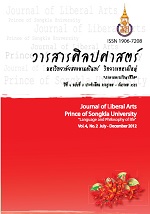A participatory process in the transmission of local wisdom of the buddha image boat procession : A case study of Ban Khaukaew community Songkla province
Keywords:
Collaborate method, Baan Khao Kaew, the Buddha Image boat processionAbstract
This study is aimed at learning the background and collaborative methods involved in preserving intellectual heritage of the Buddha image boat procession of Ban Khaukaew community in Khao Roop Chang district, Songkla province, south of Thailand. It is qualitative research, in which an in-depth interview was conducted to collect data from seven participants : two shipwrights, two monks, two elders, and one village chief. To gain more information, the researcher also participated in and observed a community meeting.
The result indicates that the Buddha Image boat procession of Ban Khaukaew was built before World War Two based on the villagers’ belief about Buddhism. The villagers believe that the Chak Pra festival would promise them seasonal rain and a lot of good deeds, and it would make their lives successful. The Buddha Image boat procession of Ban Khaukaew was periodically changed. The prow of a ship was initially carved as a Thai swan. It was made from woven bamboo. A wheel was made from wood, and not necessarily beautiful. Then, the prow of a ship was changed to kinnara. The hull was made from plywood. The wheel was covered with a tyre. Nowadays, the prow of a ship is king of nagas. The wright is more concerned about beauty. A chassis is used to build a ship, and a ship is painted with glittering colors. Foam is the most convenient material to build a ship. As far as the collaboration within the community is concerned, people can brainstorm a plan, to build the beat, give comments on the creation, and share work with voluntary spirits. It is valuable to inherit the knowledge about the Buddha Image boat procession of Ban Khaukaew since this can not only improve the relationship and harmony among people in the community, but also make Thai heritage last in the community forever.
Downloads
How to Cite
Issue
Section
License
The authors retain the copyright to their article but the Journal of Liberal Arts, Prince of Songkla University reserves the exclusive rights to first publication.





